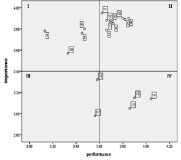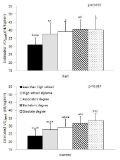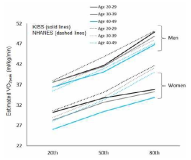
The present study has been carried out with a purpose of a long term estimation for the body size and BMI (Body Mass Index) of Korean children and youth using ARIMA, a time series model. In order to select an estimation model for the optimum time series, among the time series analysis method of SPSS22.0 statistic programs, a multivariate ARIMA (p,d,q) model has been selected that has an input series (physical education facility, time spent for physical education, animal source foods, GDP deflator, animal source food intake ratio), using annual average data of height, weight, and BMI data from 1965 to 2015. Among the several optimal measurements in ARIMA model with estimation variables, an optimal RMSE-based model (RMSE: Root Mean Square Error) has been selected. Using this model, the estimation model and estimated values of children’s height, weight, and BMI have been suggested for each age group. The results are as the following. The trend estimation of height follows a logistic curve, with both male and female groups showing increasing trends. The weight has a trend of increasing ratio higher than height. BMI also shows a trend curve similar to weight. The estimation model has been mostly ARIMA(0,1,0). In particular, the average BMI has been estimated as 22-23 for male students in 6th, 8th, 9th, 11th and 12th grade in 2030. This indicates the recent increasing obesity as children and youth occupy most of daily time for play culture that is far from physical activities, such as computer games, smartphone games, and video games at home.







Purpose The purpose of this study was to evaluate the effect of detachable forefoot outsole on muscle activity of the lower extremity during downhill walking. Methods Thirteen male university students (age: 23.5±2.1 yrs, height: 175.7±4.6 cm, weight: 651.9±55.5 N) who have no musculoskeletal disorder were recruited as the subjects. Each subject walked down 20° ramp with forefoot’s design for the detachable outsole’s angle(5°, 10° and 20°) and type(A and B). To assess the myoelectric activities of selected muscles, six of surface EMG(QEMG8, Laxtha Inc. korea, sampling frequency = 1,024 Hz, gain = 1,000, input impedance > 1012 Ω, CMRR > 100 dB) electrodes with on-site pre-amplification circuitry were attached to ES, RF, BF, TA, LG, and MG. For each dependent variable, two-way ANOVA with repeated measures was used to determine whether there were significant differences among forefoot’s design for the detachable outsole’s angle and type (p<.05). When correlation effect was not statistically significant, post hoc analyses were performed using the multiple comparison through bonferroni, and if correlation effect was statistically significant, one-way ANOVA was performed as for the form of outsole which is an inter-group variable in order to find out simple main effect, and the paired t-test was performed to find out the angle of outsole, which is an intra-group variable. Results In IDLS phase, In terms of Rectus Femoris, 10°-B outsole showed statistically higher muscle movement than 5°-B, 5°-A outsole showed statistically higher muscle movement than 5°-B, 20°-A outsole showed statistically higher muscle movement than 20°-B. Among these outsoles, Conclusion 5°-B outsole was found to the most useful outsole for improving stability and controlling the bodily movement due to the body weight load when walking down the ramp.








PURPOSE This study aims to analyze the effects of injury prevention video feedback on kinetic variables of the knee joint during the cutting maneuver. METHODS Twenty-eight healthy men participated and motion and force data were collected using infrared cameras, a force plate, and a Witty timing system. Paired t-tests were employed for data evaluation using the SPSS 26.0 program. RESULTS Results showed increased abduction and lateral rotation angles of the knee joint at the lower height of the center of mass (COM) (p<. 05). The lateral rotation of the knee joint decreased at initial ground contact (p<.05). Flexion angular velocity increased at initial ground contact after video feedback (p<.05) and decreased at the lower height of COM (p<.05). Abduction angular velocity decreased at the lower height of COM (p<.05), and internal rotation angular velocity was increased on the initial ground contact (p<.05). Maximum ground reaction force for anterior-posterior and medial-lateral directions increased after video feedback (p<.05). Flexion and internal rotation moments increased, and adduction moment also increased (p<.05). CONCLUSIONS In conclusion , video feedback effectively reduced knee load during the cutting maneuver, contributing to injury prevention for the knee joint.
PURPOSE This study aimed to analyze the moderating effect of physical fitness on the relationship between abdominal obesity and metabolic syndrome (MetS) in older women. METHODS A total of 190 participants were categorized based on waisthip ratio (WHR) into high (50%) and low (50%) groups, as well as based on Z-score of fitness into high (25%; high fit), moderate (50%; moderate fit), and low (25%; low fit) groups. Logistic regression was used to assess the relative risk of MetS based on abdominal obesity and fitness levels, and moderation analysis using the Process macro was conducted to explore the moderating effect of fitness on the relationship between abdominal obesity and MetS risk factors. RESULTS After adjusting forcovariates, logistic regression showed that high WHR (odds ratio (OR)=2.721, p=0.004) led to a significantly higher risk of MetS compared with low WHR; the high fit group (OR=0.360, p=0.044) had a significantly lower risk of MetS compared wih the low fit group. Moderation analysis revealed that the impact of abdominal obesity on MetS risk factors varied depending on the level of fitness (β=-0.495, p=0.037), and the results remained significant after covariate adjustment (β=-0.458, p=0.049). CONCLUSIONS This study suggests that the risk of MetS from abdominal obesity can be mitigated by higher levels of physical fitness. These findings highlight the need for participation in regular physical activity to maintain a high level of fitness, along with proper nutritional intake, to prevent MetS in older women.
PURPOSE This study aimed to examine the effects of an 8-week gluteus medius strengthening exercise on back pain, balance, and strength in female office workers with low back pain. METHODS The participants of this study were female office workers aged 30 to 48 years old who reported low back pain on a visual analogue scale (VAS) ranging from 3 to 7. Twenty-six participants were randomly assigned to the exercise (n=13) and control (n=13) groups. The study applied a gluteus medius strengthening program to the exercise group for 8 weeks, three times a week, and 60 minutes per session. The participants in the control group were asked to maintain their normal life patterns during the period of intervention. Data collected from the test were analyzed through repeated two-way ANOVA, paired t-test, and independent t-test. RESULTS First, there has been a significant decrease in the pain level, as evidenced by VAS and Korean oswestry disability index (KODI) scores. Second, there was a statistically significant improvement in both static and dynamic balance capabilities. Last, back strength also significantly improved. CONCLUSIONS Application of the gluteus medius strengthening exercise appears to be effective for low back pain, static and dynamic balance capabilities, and back strength.

Purpose The purpose of this study was to find out what young amateur golfers consider the most when purchasing golf apparel and to find out the Importance-Performance attributes when choosing golf apparel. Methods Amateur golfers in their 20s through 40s who have purchased golf clothing directly were selected as the subject. A total of 350 questionnaires were distributed using the purposive sampling method, and 331 copies as a final validity sample. For data analysis exploratory factor analysis Cronbach’α, frequency analysis, and Importance-Performance analysis by using SPSS 21.0. Results First, except for ‘fancy design’, ‘water-proof function’, ‘elasticity comfort’, ‘brand name’ there were significant differences between importance and satisfaction of selection attribute. Second, ‘harmonic colors’, ‘has its own characteristics’, ‘expressing beauty’, ‘elasticity comfort’ were analyzed to be situated in quadrant Ⅰ. Third, ‘fancy design’, ‘water-proof function’, ‘temperature maintenance function’, ‘elasticity and durability’, ‘brand name’, ‘high-priced yet popular brand’, ‘popular brand’ were analyzed to be situated in quadrant Ⅱ. Fourth, ‘comfortable to wear’, ‘convenient for physical activity’ were analyzed to be situated in quadrant Ⅲ. Fifth, ‘can be also worn for outdoor wear’, ‘wear for gathering’, ‘wear as daily attire’ were analyzed to be situated in quadrant Ⅳ. Conclusions The results will be the basis for effective target marketing on young amateur golfers who are rapidly emerging and will be able to grasp the characteristics of golf apparel that they really want.

PURPOSE This study aimed to investigate the effects of accelerated rehabilitation exercise on physical fitness, lower extremity isometric strength, and blood variables in older adult women diagnosed with degenerative osteoarthritis. METHODS A total of 29 older adult women diagnosed with degenerative osteoarthritis residing in G city participated in the study, and 19 participants, excluding dropouts, took part in the experiment. They underwent exercise twice a week for 60 minutes per session over a period of 12 weeks. Pre- and post-experiment, the older adult fitness assessment (SFT), lower extremity isometric strength, and blood variables were measured. Data analysis was performed using SPSS 25.0, and paired sample t-tests were conducted to examine the effects before and after exercise. RESULTS The study results showed significant differences in body mass index (BMI) before and after exercise (p<0.05), and the older adult fitness assessment (SFT) showed significant differences in all items (p<0.01). Lower extremity isometric strength showed significant differences in absolute (Nm) and relative (%BW) values of 20° right flexion muscle (p<0.01). In terms of blood variables, significant differences were observed in creatine and ESR before and after exercise (p<0.01). CONCLUSIONS This study’s results suggest that regular physical activity and rehabilitation exercise programs can positively impact the muscular strength, cardiovascular endurance, exercise function, and blood composition of older adult women diagnosed with degenerative osteoarthritis. It is indicated that conducting future research, including periodic exercise programs, could be beneficial in promoting sustained exercise participation.
Purpose Recently, studies associated with the negative physical and mental effects of athletes’ pain have received extensive attention. This study confirmed the validity of the pain catastrophizing scale (PCS) developed in clinical settings and is widely used in the sports field, and examined their relationship between the perceived stress levels and fear of pain. Methods The pain catastrophizing consisted of 13 items of three factors which are Helplessness (6 items), Rumination(4 items), Magnification(3 items). To verify the validity, PSC was revised by following the recommended revision guideline procedures. To test the validation of pain catastrophizing, 206 adult athletes were recruited including the collegiate, professional, and national levels. The participants were instructed to complete questionnaires to assess the level of pain catastrophizing, perceived stress, and fear of pain. Confirmatory factor analysis (CFA) to test the fit of measurement model was adopted to examine three higher-order three-factor measurement models. Results In results, confirmatory factor analysis indicated that the Korean version of the pain catastrophizing scale demonstrated a good model fit of measurement when removing one item with a significantly lower factor load as well as the reliability of the scale was reasonable. The pain catastrophizing had a meaningful positive direct relation with perceived stress level and fear of severe pain. In addition, construct validity and predictive validity of PCS showed valid. Conclusions Based on the results of this study, the Korean sports pain catastrophizing scale can be used to measure the subjective pain intensity of Korean athletes. In addition, it is expected to provide fundamental information for evaluating athletes’ post-injury rehabilitation processes.
Purpose The present study compared physical fitness, metabolic syndrome risk factors, and resting metabolic rate (RMR) according to body mass index (BMI) and percent body fat (%BF) in 20s females. Methods Fifty-one women in their 20s were recruited and assigned into three groups, i.e., normal group (n=18), normal weight obesity (NWO) group (n=18), and obesity group (n=15) according to BMI and %BF. Physical fitness, metabolic syndrome risk factors, and RMR were measured and compared among three groups. Results Main results were as follows: 1) Physical fitness were not significantly different among three groups. 2) Regarding 1-RM, arm curl and leg extension were significantly lower in normal group and NWO group than obesity group. Leg press was significantly lower in normal group than obesity group. 3) Regarding metabolic syndrome risk factors, there were significant differences in waist circumference, ordering from low to high such as normal, NWO, and obesity groups. Systolic blood pressure and diastolic blood pressure were significantly lower in normal group and NWO group than obesity group, while HDL-C was significantly higher in normal group than NWO group and obesity group. 4) Regarding RMR, absolute values of RMR such as VO2(㎖·min-1), RMR (Kcal·min-1), RMR (KJ·min-1), and RMR (Kcal·day-1) were significantly lower in normal group and NWO group than obesity group. On the other hand, relative value of RMR such as RMR (KJ·kg-1FW·h-1) was significantly higher in normal group than NWO group and obesity group. Conclusions It was concluded that obese women showed increased risk of metabolic syndrome and low relative RMR level, and NWO had similar problems. Active health management through physical activity and dietary control should be committed to NWO individuals because the NWO has possibility of high risk of metabolic syndrome and reduction of metabolic rate from 20s even though there was no problem in their external appearance.

To provide the distribution of cardiorespiratory fitness including Bruce treadmill exercise time and estimated peak oxygen uptake (VO2peak) and investigate association with cardiorespiratory fitness and metabolic syndrome, sedentary lifestyle, or education level among Korean adults. Analysis of data on 2,006 adults (19-64 yr) who had completed a maximal grade treadmill exercise test, from the Sports Institute of Sports Science Fitness Standards (KISS FitS) project 2014-2015. The mean maximal exercise time was 11’26’‘, 11’18’‘, 11’06’‘, 10’03’‘ and 8’51’‘ (minutes and seconds) for men 19-29, 30-39, 40-49, 50-59 and 60-64 years of age, respectively, for women, it was 9’49’‘, 9’09’‘, 8’42’‘, 8’01’‘ and 7’33’‘ for the corresponding age groups. The mean peak oxygen uptake was estimated as 42.3, 41.8, 41.2, 37.6 and 33.6 ml/kg/minute for men 19-29, 30-39, 40-49, 50-59 and 60-64 years of age, respectively, For women, it was 34.0, 31.8, 30.3, 28.0 and 26.4 ml/kg/minute for the corresponding age groups. A positive association between cardiorespiratory fitness level and education level was observed for both men and women. Furthermore, participants with sedentary lifestyle had a significantly lower cardiorespiratory fitness than participants with activity lifestyle. Finally, Men with moderate and high fitness level had 50% and 87% lower odds for the metabolic syndrome, and women had 48% and 50% lower odds for the metabolic syndrome, respectively, than the ones with low fitness level after adjustment for age, smoking, alcohol intake, and sedentary lifestyle. These results can be used to track future Korean assessments and to evaluated interventions. The differences in fitness status by education level, sedentary lifestyle or metabolic syndrome can also be used to develop health policies, program and educational services.


